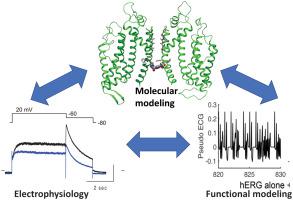Journal of Molecular and Cellular Cardiology ( IF 5 ) Pub Date : 2021-05-29 , DOI: 10.1016/j.yjmcc.2021.05.015 Kevin R DeMarco 1 , Pei-Chi Yang 1 , Vikrant Singh 2 , Kazuharu Furutani 3 , John R D Dawson 4 , Mao-Tsuen Jeng 1 , James C Fettinger 5 , Slava Bekker 6 , Van A Ngo 7 , Sergei Y Noskov 7 , Vladimir Yarov-Yarovoy 8 , Jon T Sack 8 , Heike Wulff 2 , Colleen E Clancy 9 , Igor Vorobyov 9

|
Drug isomers may differ in their proarrhythmia risk. An interesting example is the drug sotalol, an antiarrhythmic drug comprising d- and l- enantiomers that both block the hERG cardiac potassium channel and confer differing degrees of proarrhythmic risk. We developed a multi-scale in silico pipeline focusing on hERG channel – drug interactions and used it to probe and predict the mechanisms of pro-arrhythmia risks of the two enantiomers of sotalol. Molecular dynamics (MD) simulations predicted comparable hERG channel binding affinities for d- and l-sotalol, which were validated with electrophysiology experiments. MD derived thermodynamic and kinetic parameters were used to build multi-scale functional computational models of cardiac electrophysiology at the cell and tissue scales. Functional models were used to predict inactivated state binding affinities to recapitulate electrocardiogram (ECG) QT interval prolongation observed in clinical data. Our simulations demonstrate how modeling and simulation can be applied to predict drug effects from the atom to the rhythm for dl-sotalol and also increased proarrhythmia proclivity of d- vs. l-sotalol when accounting for stereospecific beta-adrenergic receptor blocking.
中文翻译:

通过多尺度建模管道确定 d-和 l-索他洛尔促心律失常倾向的分子决定因素
药物异构体的致心律失常风险可能不同。一个有趣的例子是药物索他洛尔,它是一种抗心律失常药物,包含 d- 和 l- 对映异构体,既能阻断 hERG 心脏钾通道,又会带来不同程度的致心律失常风险。我们开发了一个专注于 hERG 通道 - 药物相互作用的多尺度计算机管道,并用它来探测和预测索他洛尔的两种对映异构体的促心律失常风险的机制。分子动力学 (MD) 模拟预测了 d-和 l-索他洛尔的可比 hERG 通道结合亲和力,这已通过电生理学实验得到验证。MD 衍生的热力学和动力学参数用于在细胞和组织尺度上建立心脏电生理学的多尺度功能计算模型。功能模型用于预测失活状态结合亲和力,以概括临床数据中观察到的心电图 (ECG) QT 间期延长。我们的模拟展示了如何应用建模和模拟来预测从原子到 dl-索他洛尔节律的药物效应,以及在考虑立体特异性 β-肾上腺素能受体阻断时增加 d-与 l-索他洛尔的促心律失常倾向。



























 京公网安备 11010802027423号
京公网安备 11010802027423号